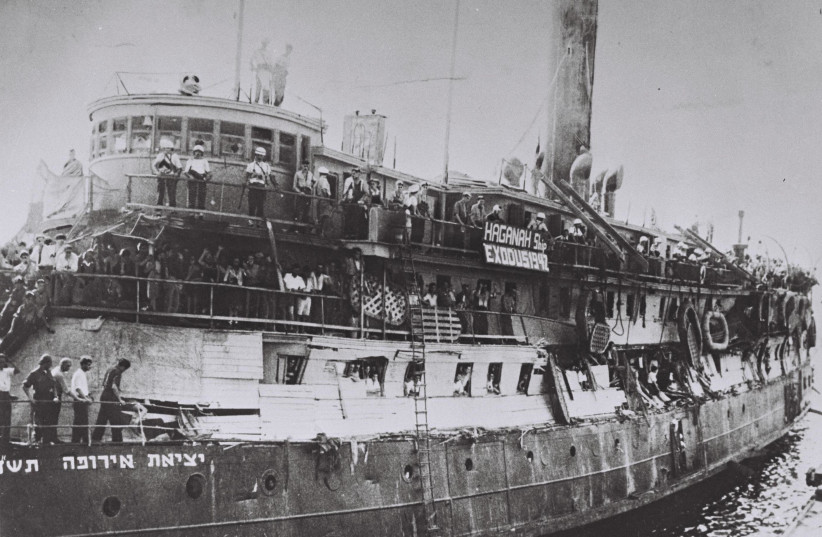The two-state solution has been proposed for decades – with the application of the titular adjective, “moderate.” Attempts to bring it about have been unsuccessful. In multiple ways, the Arab side rejects or undermines it.
It is not politically correct to ask whether rejectionism is the political and diplomatic tactic of those who imagine themselves as the Palestinian people. In today’s climate, it is unacceptable even to inquire whether it is an ideological position, a culturally inculcated pattern, or a natural outgrowth of Islamist religious construct.
Nevertheless, a short historical overview can suggest that those possibilities need be investigated. Time and again, possibilities for the conflict’s resolution, based on equitable compromise to facilitate coexistence and mutual recognition, were proposed, only to be refused, ignored, and ultimately rejected. This has been to the detriment of the Palestinian people, with the situation only worsening for them. And yet, those Arabs have not learned from this pattern.
BEGINNING IN 1915-1919, a series of meetings took place between emir Feisal (one of the heads of the Arab rebellion against the Turks, and a British ally) his father king Hussein, British officials, and Chaim Weizmann.
In January 1918, D. G. Hogarth, director of Britain’s Arab Bureau in Cairo, went to Jeddah to inform the Saudi monarch of British policy: The Arabs would be given “full opportunity of once again forming a nation” and that “no obstacle should be put in the way” of the return of the Jews to Palestine.
In March 1918 in the Al-Qibla daily, the king made clear his support of a two-state solution, writing that Palestine was “a sacred and beloved homeland” for abna’ihi-l-asliyin, “its original sons”, and the “return of these exiles (jaliya) to their homeland” would be beneficial to the region.
Weizmann traveled to Transjordan via Suez and Aqaba, with Lt.-Col. P. C. Joyce as interpreter, in January 1919. Joyce’s minutes report that Faisal repeatedly endorsed cooperation between Jews and Arabs; he “personally accepted the possibility of future Jewish claims to territory in Palestine.” Weizmann wrote to his wife that Faisal was interested in “Damascus and the whole of northern Syria” but “not interested in Palestine.”
On July 11, 1922, in a parliamentary debate, Winston Churchill declared that “No pledges were made to the Palestine Arabs in 1915” and recalled a January 20, 1921 conversation with Faisal when the emir claimed that he was “prepared to accept the statement that it had been the intention of His Majesty’s Government to exclude Palestine from the area to become the Great Arab state.” Churchill was adamant that it was the full “intention of His Majesty’s Government to exclude Palestine from the area of Arab independence.”
THAT UNDERSTANDING, nevertheless, did not prevent Churchill from adopting the two-state solution by separating the area of historic Palestine from the British Mandate territory on his famous March 27 “Sunday morning walk” in Jerusalem, following the Cairo Conference decision of March 17. It was de facto the first partition. But Abdullah never accepted a Jewish state and in 1948 sought to conquer it, despite his arrangement with Golda Meir.
A two-state mechanism was proffered by the British in 1922-23 in the form of a Palestinian Legislative Council. Ze’ev Jabotinsky considered the prospect a “threat.” Despite the council’s obvious built-in advantage for the Arabs – whereby, based on the country’s demographics, of the 12 elected members, eight were to be Muslim Arabs, two Christian Arabs, and two Jews – the Arabs, claiming to be 88% of the population, rejected the framework. They boycotted the elections and another of their opportunities was lost.
Anti-Jewish violence before State of Israel
Anti-Jewish violence and terror by Arabs were a constant element that doomed the two-state solution.
The April 1920 riots in Jerusalem were partially responsible for the separation of Transjordan from the area of the Jewish national home. In 1922, the League of Nations withheld the application of the Mandate’s provisions east of the Jordan River following the riots of May 1921 in Jaffa, Hadera, Kfar Saba and Petah Tikva.
In the year following the outbreak of what became a three-year terror campaign, during which over 500 Jews were murdered, the British came up with the 1937 Partition Plan. It went through various versions but all were rejected by the Arabs. That situation brought about the 1939 White Paper that reneged on the Peel Commission’s idea of partitioning Palestine and calling only for the establishment of a Jewish national home in an independent Palestinian state within 10 years. Yet, in June 1939, mufti Mohammed Amin al-Husseini turned even that White Paper down.
The United Nations, after deliberations, proposed the November 1947 partition scheme. Once more, the leadership of the Mandate’s local Arab community followed the mufti’s diktat, and once again rejected any compromise that would facilitate Jewish political sovereignty on any of the Mandate’s territory.
Following Israel’s victory in 1967, the government convened on June 19, 1967. The resolution, unanimously adopted, offered Egypt and Syria peace treaties with security assurances for Israel and implied a willingness to withdraw from the Golan Heights and the Sinai Peninsula in exchange for peace. Only Jerusalem was to be claimed.
The Arab rejection came on August 1 that year, at the Arab League’s Summit when it adopted the “Three No’s” resolution: No to peace with Israel, no recognition of Israel, and no negotiations with Israel.
All other plans and proposals such as those of Moshe Dayan, Yigal Allon, Menachem Begin, and the Oslo Accords similarly and consistently floundered on the bedrock of rejectionism. Moreover, there appears to be an authoritarianism in pro-Palestine rhetoric restricting the ability of those Arabs who assert themselves as Palestinians and that of their international supporters, to exit this paradigm of rejectionism. They are stuck in rejectionist rut.
A century of conflict would seem to prove that there is no two-state solution and that it would be a dangerous option to pursue.
The writer is a researcher, analyst, and opinion commentator on political, cultural, and media issues.

